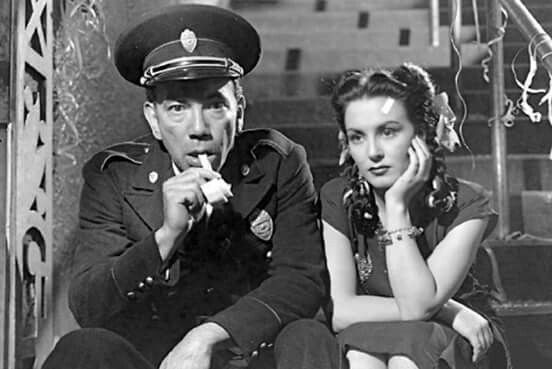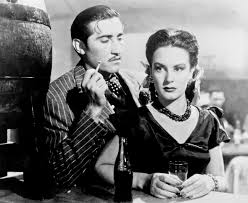
Salón México (1949) is a cabaretera, a uniquely Mexican genre about a woman with a heart of gold who is forced by poverty to work as a singer in a sketchy nightspot or even as a prostitute. In Salón México, Marga López stars as the devoted Mercedes, who is working as a B-girl in a nightclub, and is not above fleecing her customers. She is debasing herself and is scraping by in a hovel for the greater good – she spends every ill-gotten peso to pay for a private boarding school for her gifted little sister. The equally pure-hearted middle-aged beat cop (Miguel Inclán – here decidedly not in one of his usual villainous roles) is sweet on her. In fact, every character in Salon Mexico is positively saintly, except for the local pimp Paco (Rodolfo Acosta), who packs all of Salon Mexico’s villainy into one profoundly scummy dude.
Acosta will be a familiar face to viewers of American TV in the 50s and 60s, where he was a go-to guy for Mexican roles, along with the occasional Native American. After 1953, he amassed 93 screen credits on American movies and TV during the Golden age of the Western. including a regular role on High Chaparral.

Emilio Fernandez movies are generally known for their rural and historical settings, but Salon Mexico is a Fernandez take on contemporary Mexico City. The film is also a post-war Mexico City time capsule, with visits to the Zocalo, the Catedral and the Museo Nacional, along with glimpses into a snooty private school, a hardscrabble barrio, a red light district and even a military airfield.
BTW the nightclub of the movie’s title is one hoppin’ joint and looks like a very fun nightspot.
Besides the setting of the nightclub district and most of the action happening at night, the noir aspect of Salon Mexico is the story’s arc toward something between an operatic tragedy and the inevitable noirish doom.
I saw Salón México at the 2020 Noir City as part of its Fiesta of Mexican Noir. It is not available to stream, but the DVD is available, as is a bootleg version on YouTube.
